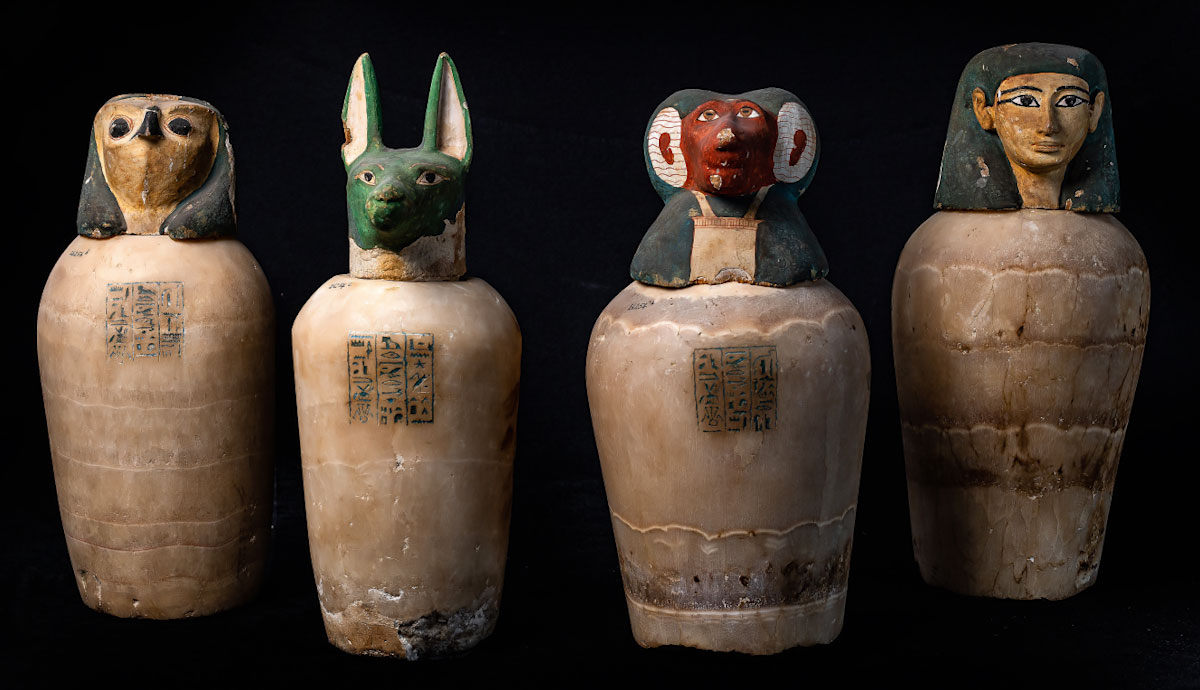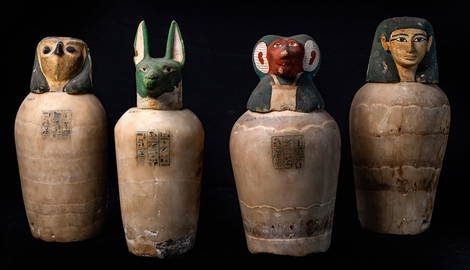
The preparation for the Afterlife in ancient Egypt was no small task. Not only did people need to live a righteous life, have their own tombs built by experts, overcome the Trial of the Dead, and learn the exact directions to the underworld. Their bodies also needed to be correctly mummified, including having their most precious organs carefully extracted and placed in four specific vessels that stood for each of the Four Sons of Horus, gods that had the important mission of preserving those organs for all eternity. These vessels are known as canopic jars.
What Is a Canopic Jar?

Any dictionary will tell you that the word “Canopic” means of or pertaining to Canopus, a Greek commander that fought in the Trojan War. Canopus was the helmsman of the hero Menelaus after the successful campaign in Troy. While ashore on the northern coast of Egypt, he was bitten by a snake and died. Menelaus had a monument built to his memory, and a town developed there that was named after him. It was thought in Classical Greek times that the local Egyptians worshipped Canopus as a divine being, represented in the form of a jar with small feet, a thin neck, a swollen body, and a round back. It is unclear whether this had been a misunderstanding made by the Greek travelers or a deliberate fabrication, but the truth is that Canopus was never revered in Egypt.
However, the Egyptians did have small jars, often with carved lids in the form of gods, that were sacred and meant to be stored together with the body of the deceased in their tombs. Each of these jars held a particular organ that had been carefully extracted from the dead by the priests that performed the mummification rites. Thanks to the wrong association between these jars and the legend of Menelaus and Canopus, they became known as Canopic Jars, and however incorrect this definition may be, scholars found no reason to change the term.
The Egyptian Afterlife

In order to understand the strange (to us) custom of storing organs in small vessels, one needs to be acquainted with the basics of the Egyptian beliefs in Afterlife. First of all, they did not have a concept akin to our “soul”, but instead, they believed that the body was comprised of different entities or substances. And they all continued to live after death, the physical body included. This is why they needed to preserve it in the best fashion they could (see the next section). For the same reason, the Egyptians often placed either fresh food or models of food inside the tombs, so the deceased could be adequately fed even after death.
Without the proper rites, it was believed that people would fail to reach the underworld, where eternal life expected them. Egyptians believed that not everyone was entitled to eternal life in the underworld. This is why every dead person had to make a stop at the so-called Hall of Maat, where a trial took place. There, Anubis weighed the heart of the deceased on a scale, against a feather. If the heart was lighter than the feather, the dead person could go forward into the underworld. But even then, it was a tricky voyage, so Egyptians wrote all kinds of books and manuals with precise directions and even maps on how to reach the place of eternal life.
Mummification in Ancient Egypt

Since the beginning of their history, the Egyptians constantly improved their mummification techniques. As most humans and a huge amount of animals were routinely operated after their demise, embalmers had quite a comprehensive understanding of bodies and their organs. According to their beliefs, certain organs such as the intestines, liver, lungs, and stomach were necessary for the Afterlife, as they assured the continuation of life in the next world. This is why, during the burial rituals, these four organs were stored in their own separate jars. The heart, however, as it was the seat of the soul, was left inside the body. Curved tweezers were used to pluck the brain out of the head through the nostrils, and it was later disposed of because they did not believe it was an important organ.
The four main organs, however, were carefully embalmed and preserved. Apart from these organs, all the moisture was taken away from the body, and it was treated with a concoction that varied through the years but generally consisted of several layers of wrappings and oily resin. Once mummified, the body was put inside a coffin and several sarcophagi.
Who Were the Four Sons of Horus?

According to the Pyramid Texts, Horus the Elder fathered four sons: Duamutef, Hapy, Imsety, and Qehbesenuef. The texts, however, are not clear as to who the mother is. Other sources claim that Osiris, the god of the dead, was the father of these gods, and according to other texts they were born from a lily or a lotus flower. Although they first appear in the Old Kingdom Pyramid Texts, the four sons became prominent figures from the Middle Kingdom onwards as protectors of the viscera of the deceased. Each one of the sons Sons of Horus was in charge of the protection of an organ. In turn, each son was accompanied and protected by designated goddesses.
1. Hapy
Also spelled Hapi, he was the baboon-headed god who protected the lungs. He represented the North and had the protection of the goddess Nephthys. Hapy also had the role of protecting the throne of Osiris in the Underworld.
2. Duamutef
A jackal-headed god, Duamutef protected the stomach. He represented the East, and his consort was the goddess Neith. Duamutef means “he who protects his mother”.
3. Imsety
Imsety had a human head and was in charge of guarding the liver. He represented the South and was protected by Isis. His name stands for “the kind one”. He was the only Son of Horus not to have an animal representation.
4. Qebehsenuef
Qebehsenuef was the falcon-headed Son of Horus who protected the intestines. He represented the West, and his accompanying goddess was Serket. Apart from guarding the intestines, Qebehsenuef was also tasked with refreshing the body of the deceased with cool water.
Canopic Jars Through History

Canopic Jars first appeared early during the Old Kingdom, at first as simple containers with no inscriptions, just large enough to hold the specific organs. These containers evolved, and at the height of the Middle Kingdom, they all had complicated carvings, and the lids were fashioned in the form of the heads of each Son of Horus.
By Dynasty 19 of the New Kingdom, Canopic Jars no longer held the organs inside them. Instead, the Egyptians kept the organs inside the mummified bodies, as they had always done with the heart. However, although the Canopic Jars no longer held the organs and had small or no cavities, they still featured the sculpted head of the Sons of Horus on their lid. These were called Dummy Jars, and were used more as symbolic objects to signify the importance and protection of the gods, rather than as practical artefacts.
Preparing for the Afterlife

Egyptian tombs were essentially a “microcosm” of the world outside the tomb. This means that they were planned and constructed as if they were replicas of the outer world, complete with everything that was needed to live a full (after)life. We have mentioned the foods and the embalming process that was meant to preserve the body. During certain periods, mummies were periodically exhumed, and a ritual known as the Opening of the Mouth was performed. The aim of such a ceremony was to let the dead person breathe and communicate verbally with their living relatives. During most of Egyptian history, however, it was performed only on statues or coffins.
Inside the tomb, there would be all kinds of furniture and household objects, as well as clothes, sandals, and the favorite games and pets of the deceased. This assured them that they would never need anything from the world of the living while in the underworld. Tutankhamun even had actual chariots buried with him, so as to ensure the king’s transportation after his death. Preparation for death was indeed a huge and profitable industry in ancient Egypt.
Why Are Egyptian Canopic Jars Important?

So far, we have learned how the Egyptians extracted the liver, intestines, lungs, and stomach of the dead and that they placed each of them in a separate container. These containers were then buried in the same tomb as the actual mummy. This may seem unfamiliar and interesting, but it is also important for other reasons. Thanks to these procedures, performed generation after generation over centuries, the ancient Egyptians gained an enormous knowledge about the human body. This explains why, of all the peoples of Antiquity, the Egyptians had the most advanced knowledge of anatomy and medicine. Many treatments of common diseases came from Egypt, and their developments in surgery, gynecology, and even dentistry, are, to this day extremely impressive. This also proves that rituals and beliefs are not just curious but also have shaped the society we live in.










